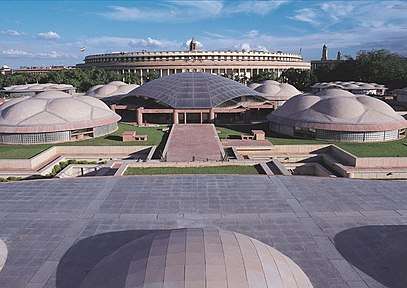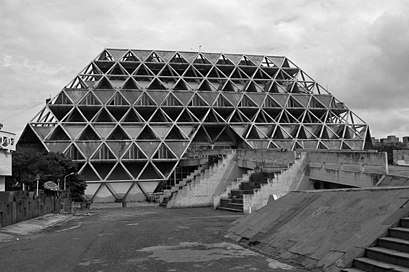Raj Rewal
Raj Rewal is a leading Indian architect.[1] A distinguished doyen of architecture from India, Raj Rewal has set global precedents with his urban narratives of design that have been integrally and richly steeped in their contextual inferences. The concerted juxtaposition of traditional concepts and contemporary syntax is reflective of his fascination for weaving expressions of heritage and history into a modern vocabulary, often revealing layer upon layer of intuitive interpretation and deep meaning. Effortlessly threading together episodes of design, he merges scale with surroundings and geometry with rhythm, binding space with structure and nuance, modulating form and light and coursing the exterior through the interior to create a series of interconnected experiences that are as distinct as they are together. Across a repertoire of residential, housing, public and institutional buildings, his work is characterised by concern for climatic sensitivity, humane architecture and the promotion of craftsmanship and new technologies.[2]
Raj Rewal | |
|---|---|
| Born | 1934 Hoshiarpur, Punjab, India |
| Nationality | Indian |
| Occupation | Architect |
| Buildings | Asiad Village, Parliament Library, Hall of Nations, STC Building, New Delhi |
Early life
Raj Rewal was born in hoshiarpur, punjab, India.[3]
Career
Rewal lived in Delhi and Shimla from 1934–1951. He attended Harcourt Butler higher secondary school. Between 1951-1954 he attended the Delhi School of Architecture in New Delhi. After completing a degree in architecture in New Delhi, he moved to London in 1955 where he lived until 1961. He attended the Architectural Association School of Architecture for one year and the Brixton School of Building, London from 1956-60.[4] GD Goenka University also honour architect Raj Rewal with an honorary doctorate at a special convocation organised by University in India Habitat Centre.
Raj Rewal worked at Michel Ecochard's office in Paris before starting his practice in New Delhi in 1962. Between 1963-72, he taught at the School of Planning and Architecture, Delhi. He opened a second office at Tehran, Iran in 1974. Among his better known projects are the Hall of Nations (Hall 6) at the Pragati Maidan Exhibition Centre,[5] demolished in April 2017,[6] Asiad Village Complex, National Institute of Immunology (NII), New Delhi; the Parliament Library in New Delhi and NCBS (National Centre for Biological Sciences) campus at Bangalore.[7][8] In 1986, he became the curator of the exhibition "Traditional Architecture in India" for the Government of India organised festival of India in Paris.He also designed an architectural college (SIUPA) in Rohtak and is head of members in academic council.
Awards
- Gold Medal 1989 by the Indian Institute of Architects.
- Robert Mathew Award 1989 by the Commonwealth Association of Architects.
- Mexican Association of Architects award in 1993 for regional values.
- Architect of the Year 1994 Award by J.K. Trust for the design of World Bank Resident Mission building in New Delhi.
- Great Master's Award 1995 by J.K. Trust for lifetime contribution to Modern Architecture in the post independence era in India.
- Lifetime achievement award 2001 by the Institution of Engineers (India).
- IBC award 2002 by the Indian Building Congress for Excellence in Built Environment for Parliament Library building, New Delhi.
- Golden Architect Award 2003 by A+D and Spectrum Foundation
- Chevalier des Arts des Lettres award, 2005 by the French Government
- Knight of the Legion of Honour[9]
- John Michael Kohler Life Time Achievement Award[10]


Projects
- Asian Games Village, New Delhi
- Bio Port, Sohna
- Central Institute of Education Technology, New Delhi
- Cidco Housing, Navi Mumbai
- Coal India Complex, Kolkata
- Delhi Metro Rail Corporation Headquarters, New Delhi
- Energy Technologies Center, NTPC Limited, Greater NOIDA
- Engineers India House, New Delhi
- Gas Training Institute, NOIDA
- French Embassy Staff Quarters, New Delhi
- Satish Gujral House, New Delhi
- Grapecity - Japanese Software Center, NOIDA
- Hall of Nations, Pragati Maidan, New Delhi
- Indian Embassy, Beijing (China)
- Housing for British High Commission, New Delhi
- Indian National Science Academy, New Delhi
- International Centre for Genetic Engineering and Biotechnology, New Delhi
- Jang-e-Azadi Memorial and Museum, Kartarpur, Punjab
- National Brain Research Institute, New Delhi
- National Centre for Biological Sciences, New Delhi
- Lisbon Ismaili Centre, Lisbon (Portugal)
- National Institute for Immunology, New Delhi
- National Institute of Public Finances and Policy, New Delhi
- NTPC Tower, NOIDA
- Parliament Library at Sansad Bhawan, New Delhi
- Rewal House, New Delhi
- Sahu Jain Pavilion, Pragati Maidan, New Delhi
- Sheikh Sarai Housing, New Delhi
- Sham Lal House, New Delhi
- Standing Conference of Public Enterprises Office Complex, New Delhi
- State Trading Corporation, New Delhi
- Television Centre (Doordarshan Bhawan), New Delhi
- Visual Arts Institutional Campus, Rohtak
- World Bank Regional Mission, New Delhi[12]
References
- http://www.architectureweek.com/2003/1022/design_1-1.html
- "Raj Rewal". www.ombooksinternational.com.
- Weiler, Katharina. Authenticity in Architectural Heritage Conservation.
- "Raj Rewal Education".
- "Raj Rewal Experience". Archived from the original on 11 June 2013.
- Suneet Zishan Langar. The Demolition of Delhi's Hall of Nations Reveals India's Broken Attitude to Architectural Heritage. ArchDaily, 23 June 2017
- "Better Known Projects".
- "History". NCBS. Retrieved 9 April 2018.
- "Raj Rewal receives Legion of honor". 22 March 2016.
- "Economic Times on Raj Rewal".
- "Parliament Library".
- "Raj Rewal Projects".